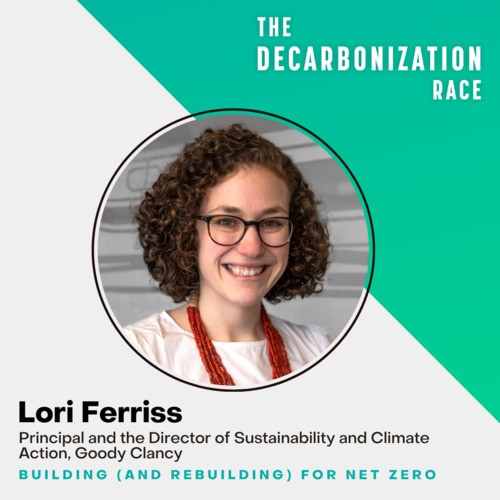
Building (and Rebuilding) for Net Zero with Architect Lori Ferriss
Episode · 0 Play
Episode · 32:35 · May 29, 2023
About
On this episode of the Decarbonization Race, Lincoln Payton dives deep into the world of sustainable architecture with architect Lori Ferriss, who’s worked across her career to square sustainability, historic preservation and aesthetic concerns in cities swimming in history, like Boston. As Director of Sustainability and Climate Action at Boston architectural firm Goody Clancy, Lori leads research initiatives and project design and implementation serving a range of sectors including higher education. For Lori, building reuse is a significant form of climate action. Her far-reaching work has expanded the role of architects while simultaneously elevating building reuse as a prime way to combat climate change. Lori and Lincoln discuss the interplay between both operational and embodied carbon in buildings, debating investments to reduce carbon emissions through retrofitting or new-build construction (including with the Carbon Avoided Retrofit Estimator or CARE Tool, which Lori helped develop), policies passed by cities like London and Cambridge, Massachusetts that prioritize life cycle assessments and emissions disclosure, and changes in the materials being used like biogenic materials for insulation or green cement or steel. Key Takeaways: Boston has implemented policies and ordinances to achieve net-zero operations for commercial buildings such as the Building Energy and Reporting Disclosure Ordinance (BERDO 2.0) to achieve net-zero operations for commercial buildings over 20,000 sqft. BERDO 2.0 requires disclosure and reporting followed by reductions, with a financial penalty for non-compliance. Boston's zero net carbon zoning policy complements BERDO by requiring new buildings to meet similar standards. Biogenic materials are becoming more viable for commercial construction. These natural materials like wood, cross-laminated timber, hemp, and straw bale are becoming more viable for commercial construction, with their environmental benefits dependent on where the materials come from, how they are produced, and they are disposed of or repurposed at the end of their life cycle. The CARE (Carbon Avoided Retrofit Estimator) Tool was developed to help planners, owners, and design professionals calculate the total embodied and operational carbon of existing buildings after energy efficiency upgrades or renovations. CARE can help estimate the environmental value of reusing existing buildings, and inform decisions on whether to retain buildings or demolish and build new ones. Resources A Better City blog post, "BERDO 2.0 Explained" Carbon Avoided Retrofit Estimator (CARE) Tool Architecture 2030
32m 35s · May 29, 2023
© 2023 Libsyn